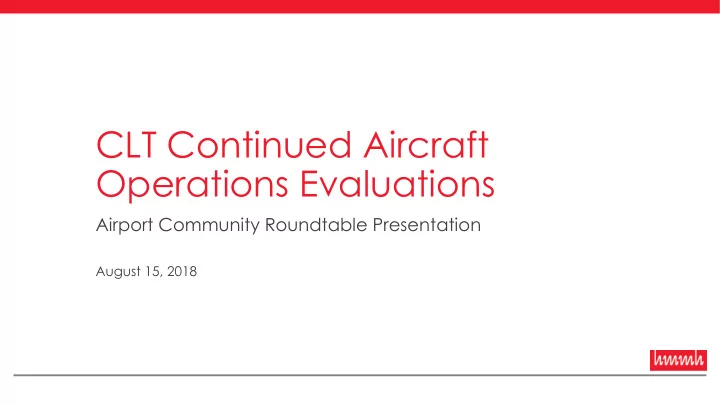

CLT Continued Aircraft Operations Evaluations Airport Community Roundtable Presentation August 15, 2018
ACR Requests of the CLT Technical Consultant Continued review of open ACR motions • Increase Base Leg Altitudes on Arrival into CLT (ACR Motion 01-18/02-18) • Optimized Profile Descents into CLT (ACR Motion 01-17) • Delay Runway 18L Turnout on Departure (ACR Motion 00-18) 2
Increase Base Leg Altitudes on Arrival into CLT (ACR Motion 01-18/02-18) 3
36R CLT Altitude Profiles – East Downwind 2017 2014 4
36R CLT Altitude Profiles – East Downwind Downwind Downwind Portion Portion 2017 2014 5
CLT North Flow East Downwind – 2014 Altitude Profiles North South 2nm 5nm 8nm 11nm 14nm 17nm Airport Elevation: 748 21nm 24nm 27nm 6
CLT North Flow East Downwind – 2017 Altitude Profiles North South 2nm 5nm 8nm 11nm 14nm 17nm Airport Elevation: 748 21nm 24nm 27nm 7
CLT North Flow East Downwind – 2014 and 2017 Altitude Profile Comparison North South Airport Elevation: 748 8
Findings – North Flow East Downwind Altitude Analysis Downwind altitudes were higher in 2014 (pre-metroplex) than 2017 (post- metroplex) consistent with prior analysis Altitudes at the start of the downwind leg (northeast of the airport) could be increased without departure traffic conflicts No departure traffic conflicts at the middle and end of the downwind leg(abeam and southeast of the airport), however: • Increasing altitudes at these locations could result in aircraft flying further southeast of the airport to meet glideslope capture as well as aircraft operator and performance requirements • Could present sequencing issues during peak traffic periods 9
Optimized Profile Descents into CLT (ACR Motion 01-17) 10
CDA Analysis Methodology – Proposed Procedure Development Selected 2017 north flow east downwind operations for evaluation of a Continuous Descent Approach (CDA) • Runway 36R • Potential area for development of a Required Navigation Performance (RNP) approach procedure Generated model flight track of average lateral and vertical profiles for selected operations to represent exiting conditions • Derived from 9,268 flight tracks • Average vertical profile included aircraft level segment at 6,000 ft. above Mean Sea Level (MSL) on downwind Developed proposed RNP approach with continuous 3-degree descent profile from start of downwind leg to the runway 11
Runway 36R Continuous Descent Approach (CDA) – Model Flight Track Development 6,000’ MSL Level Segment 12
CDA Analysis Methodology – Noise Modeling Modeled and compared noise results for two most common arrival aircraft types at CLT • Airbus A321 • Canadair Regional Jet 900 (CRJ9) • Existing condition model track and proposed RNP approach Generated and compared Sound Exposure Level (SEL) Contours for modeled operations Calculated and compared Maximum Sound Exposure Level (Lmax) at selected community location near Runway 36R east downwind (SouthPark Mall) 13
A321 – 2017 Existing Condition (left) and Proposed RNP CDA (right) SEL Contours 14
CRJ9 – 2017 Existing Condition (left) and Proposed RNP CDA (right) SEL Contours 15
Findings – CDA Analysis Proposed RNP CDA SEL Contours for both aircraft types are smaller than those for existing conditions • Result of reduced aircraft thrust and higher altitudes on downwind leg • SEL Contours converge as aircraft approach airport due to glideslope and descent requirements Proposed RNP CDA Lmax values at SouthPark Mall for both aircraft types are 3-4 dB less than existing conditions • A321 Existing conditions: 57.0 dB Proposed RNP CDA: 52.9 dB • CRJ9 Existing conditions: 54.4 dB Proposed RNP CDA: 51.4 dB Implementation of the RNP CDA as proposed could negatively impact arrival sequencing during peak traffic periods due to limited altitude flexibility for air traffic controllers 16
Delay Runway 18L Turnout on Departure (ACR Motion 00-18) 17
18L and 18C Departure Turn Gate Analysis To analyze altitude conflicts, we developed two analysis gates • Southeast of CLT in the area where 18L departures turn East • Southwest of CLT in the area where 18C departures turn West 2014 18
Departure Gate Analysis (SE) – 2014 Northeast Southwest 19
Departure Gate Analysis (SE) – 2017 Northeast Southwest 20
Departure Gate Analysis (SE) – 2014 Compared to 2017 Northeast Southwest Northeast Southwest 2017 2014 21
Departure Gate Analysis (SW) – 2014 Southeast Northwest 22
Departure Gate Analysis (SW) – 2017 Southeast Northwest 23
Departure Gate Analysis (SW) – 2014 Compared to 2017 Southeast Southeast Northwest Northwest 2017 2014 24
Findings – 18L and 18C Departure Turn Analysis Delaying left (southeast) Runway 18L and right (southwest) Runway 18C departure turns would result in potential traffic conflicts with south flow downwind arrivals Turning aircraft later would not result in higher aircraft altitudes due to need to keep departures vertically separated below arrivals • Could result in potential extended level flight segments • Potential to increase aircraft noise Delaying Runway 18L and 18C departure turns could potentially be accomplished by increasing south flow east and west downwind altitudes 25
Discussion CLT Technical Consultant to the ACR 26
Recommend
More recommend